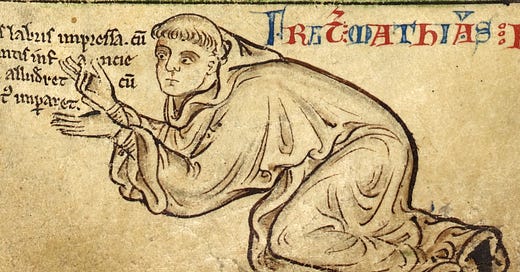Strange Stories From The Chronicles: Blood-Red Eclipses and The Five Moons Over York
Did the medieval chroniclers really see strange phenomena in the skies above England in 1200?
Since beginning my journey as a writer more than fifteen years ago, life has taken me to many memorable locations and introduced me to some truly intriguing subjects. Among the great perks is researching historical manuscripts, notably medieval chronicles. Even now, it’s a process I thoroughly enjoy. Only through the eyes of the literary monk have I found it possible even to begin to understand the workings of the medieval mind.
Though most medieval chronicles possess certain consistencies, no two are identical. Some cover matters of great importance: legendary battles, coronations, the visits of esteemed dignitaries and so forth. Others are more mundane, focusing on local issues, such as feast days, minor squabbles or the implementation of canon law.
Then there are those that are just plain bonkers - quite literally out of this world. From the stories of green children or wild men in Suffolk, blood raining down from angry skies, strange lights in the dead of night or whirlpools swallowing King John’s washed-up treasure, few things rival the commentary of the rambling cleric.
Two particularly memorable examples concern the early reign of King John. A three-hour eclipse of the moon was reported to have made it shine blood red and emit rays like fire on 3 January 1200. For December of that year, the annalist of Burton and the prominent chronicler of St Albans, Roger of Wendover, echoed the musings of the Yorkshire chronicler Roger of Howden that five moons were spotted in the skies above the province of York. While four appeared at each point of the compass, a fifth, accompanied by several stars, began in the centre of the four before making a circuit of each one. After an hour of wowing the astounded eyewitnesses, the additional moons vanished without a trace.
What are we to conclude from such matters? Were the people of Yorkshire witnesses to uncommon astrological activity? A meteor shower? Multiple eclipses? The effects of lousy mead? Too much mead? Not enough mead? Too much water (h20 was often rich in bacteria back then and should be avoided like the plague!). Were they witnessing genuine UFO behaviour? Acts of God? Portents of genuine doom?
Or is there a more down-to-earth explanation?
Regarding the blood-red eclipse, the likely answer is straightforward. The moon will often turn red during a lunar eclipse due to how the sun’s light hits our atmosphere (see below, source: Wikipedia). Likewise, the fiery rays were almost certainly the usual sun’s rays passing through our atmosphere. Even in John’s reign, such a sight was relatively common, albeit usually welcomed with feelings of deep foreboding.
The sight of five moons, on the other hand, is less common. Is it possible the chronicler stumbled upon actual phenomena? Somewhat surprisingly, the answer might be yes. One possibility is that the five moons were the product of an earthly optical illusion, not unlike a mirage in the desert. For this to be the case, the light must pass through two layers of air with different temperatures. The fact that the sighting was reported in December might suggest it was freezing cold, which can also cause mirages. Another possibility is that the eyewitnesses saw the moon through thick glass, possibly during heavy rain. A third possibility is that the likes of Venus, Mars, Saturn and Jupiter were uncommonly huge as they rose alongside the moon on the night in question. Even with the naked eye, Jupiter and Venus, in particular, can be incredibly bright on occasion.
A fourth explanation is that the people of Yorkshire were greeted by the sight of Moon Dogs. Though relatively rare, Moon Dogs or mock moons are an atmospheric optical phenomenon, creating the illusion that the regular moon has bright spots on one, two or all four sides (an example of which can be seen below, source: Wikipedia).
So, what actually happened? Did Roger of Howden and the people of Yorkshire really encounter astronomical sights of wonderment? In truth, we’ll never know. However, in my opinion, there is every possibility the sights were genuine. Coming at a time when astronomy and astrology were deeply intertwined, and such things were viewed as communications from the heavens, it is little surprise that the people of England viewed them with great trepidation.
As the turn of the millennium showed, the new king had plenty to worry about. That year, John ventured to France to conclude the Treaty of Le Goulet with the King of France, culminating in Philip II’s (Augustus) agreeing to officially acknowledge John as Duke of Normandy. In return, John parted with 30,000 marks and submitted to Philip as overlord of the French fiefs - the one exception was the duchy of Aquitaine, which remained the possession of John’s mother, Eleanor. John’s willingness to give up so much for so little was widely lamented in England and undoubtedly hastened Philip’s taking of Normandy in 1204.
Regardless of whether the strange astronomical bodies were genuinely portentous, for John, his reputation as Softsword was already well on its way to being born.
The above stories were included in my book, King John, Henry III and England’s Lost Civil War, published by Pen&Sword History.







